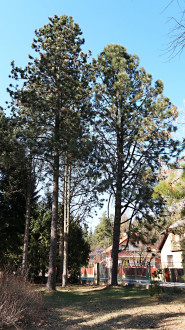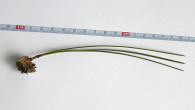(Pinus ponderosa Douglas ex C. Lawson)
Habitus
- a massive tree growing to a height of 50 - 70 m
- the crown is conical, slender, later ellipsoidal, dense
- branches grow in spikes, they are thick, they protrude almost horizontally
- the bark is greenish-brown, later it changes to a dark brown to blackish deeply cracked bark
Leaves (assimilation organs)
- assimilation organs needle-like
- needles are 120 - 260 x 1.5 mm in size , sharply pointed, finely toothed along the edge, triangular in cross-section, firm, standing straight out
- needles are grouped in bundles on brachyblasts, usually 3 (exceptionally 2 - 5), last 3 years
Flowers
- wood monoecious, flowers unisexual, blooms in May
- ♂ cones are cylindrical, violet, purple-yellow to brownish when ripe, grow at the base of this year's shoots
- ♀ cones are broadly ovoid to round, 10 - 15 x 10 mm in size, dark red, slightly stalked, later purple, grow at the end of this year's shoots in whorls of 3 – 5
Fruits – seeds
- the fruit is a cone 10 - 15 x 5 - 6 cm large, egg-conical, sessile, yellow-brown to reddish-brown, shiny
- the navel is more prominently raised with a firm straight or curved thorn at the top
- the cone ripens in autumn the second year, after ripening it quickly opens and falls off, a rosette of seed scales remains on the branch
- the seed is 7 - 10 x 5 - 6 mm large, ovoid, dark brown, the wing is 20 - 30 mm long, light brown
Extension
- grows in the western part of the North American continent , in the north from British Columbia, in the south to California, in the east to South Dakota and Texas, at altitudes from 300 to 2,600 m above sea level. m. on dry slopes and in valleys
- it was introduced to Europe in 1827
Ecology
- it is a light-loving tree, it grows well in drier habitats
- it does not tolerate very wet and shallow soils
- in severe winters it is damaged by frosts
Significance
- a decorative tree prized for its nice habit and impressive long needles at the ends branches.













